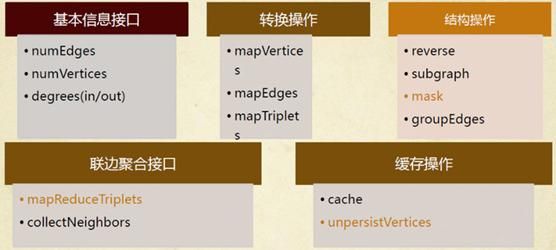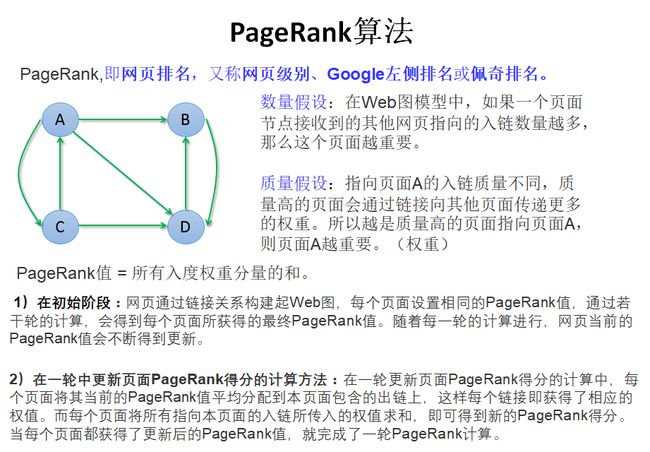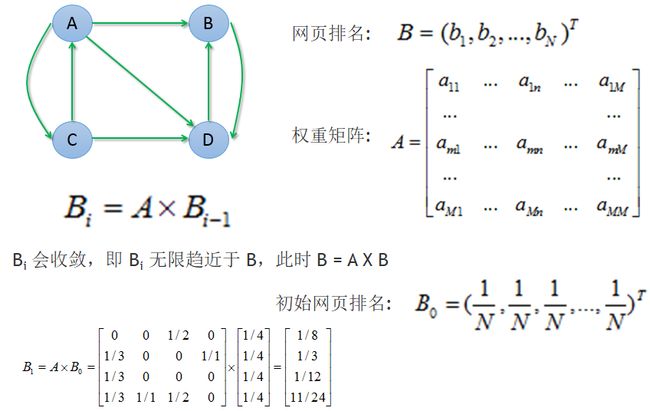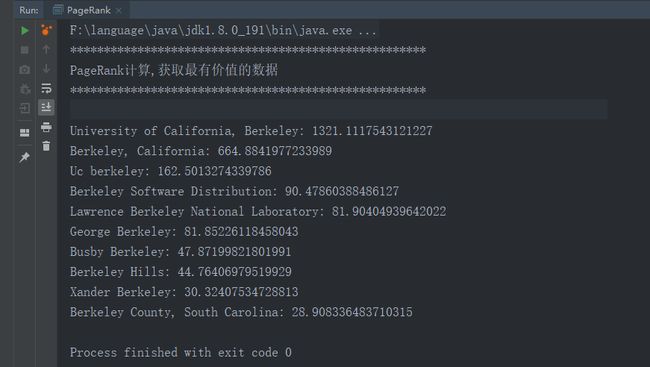1
2
3
4
5
6
7
8
9
10
11
12
13
14
15
16
17
18
19
20
21
22
23
24
25
26
27
28
29
30
31
32
33
34
35
36
37
38
39
40
41
42
43
44
45
46
47
48
49
50
51
52
53
54
55
56
57
58
59
60
61
62
63
64
65
66
67
68
69
70
71
72
73
74
75
76
77
78
79
80
81
82
83
84
85
86
87
88
89
90
91
92
93
94
95
96
97
98
99
100
101
102
103
104
105
106
107
108
109
110
111
112
113
114
115
116
117
118
119
120
121
122
123
124
125
126
127
128
129
130
131
132
133
134
135
136
137
138
139
140
141
142
143
144
145
146
147
148
149
150
151
152
153
154
155
156
157
158
159
160
161
162
163
164
165
166
167
168
169
170
171
172
173
174
175
176
177
178
179
180
181
182
183
184
185
186
187
188
189
190
191
192
193
194
195
196
197
198
199
200
201
202
203
204
205
206
207
208
209
210
211
212
213
214
|
import org.apache.log4j.{Level, Logger}
import org.apache.spark.graphx.{Edge, _}
import org.apache.spark.rdd.RDD
import org.apache.spark.{SparkConf, SparkContext}
object Practice extends App {
Logger.getLogger("org.apache.spark").setLevel(Level.ERROR)
Logger.getLogger("org.eclipse.jetty.server").setLevel(Level.OFF)
val conf = new SparkConf().setAppName("SimpleGraphX").setMaster("local[4]")
val sc = new SparkContext(conf)
val vertexArray = Array(
(1L, ("Alice", 28)),
(2L, ("Bob", 27)),
(3L, ("Charlie", 65)),
(4L, ("David", 42)),
(5L, ("Ed", 55)),
(6L, ("Fran", 50))
)
val vertexRDD: RDD[(Long, (String, Int))] = sc.parallelize(vertexArray)
val edgeArray = Array(
Edge(2L, 1L, 7),
Edge(2L, 4L, 2),
Edge(3L, 2L, 4),
Edge(3L, 6L, 3),
Edge(4L, 1L, 1),
Edge(2L, 5L, 2),
Edge(5L, 3L, 8),
Edge(5L, 6L, 3)
)
val edgeRDD: RDD[Edge[Int]] = sc.parallelize(edgeArray)
val graph: Graph[(String, Int), Int] = Graph(vertexRDD, edgeRDD)
println("属性演示")
println("**********************************************************")
println("找出图中年龄大于30的顶点:")
graph.vertices.filter { case (id, (name, age)) => age > 30 }.collect.foreach {
case (id, (name, age)) => println(s"$name is $age")
}
println
println("找出图中属性大于5的边:")
graph.edges.filter(e => e.attr > 5).collect.foreach(e => println(s"${e.srcId} to ${e.dstId} att ${e.attr}"))
println
println("列出边属性>5的tripltes:")
for (triplet <- graph.triplets.filter(t => t.attr > 5).collect) {
println(s"${triplet.srcAttr._1} likes ${triplet.dstAttr._1}")
}
println
println("找出图中最大的出度、入度、度数:")
def max(a: (VertexId, Int), b: (VertexId, Int)): (VertexId, Int) = {
if (a._2 > b._2) a else b
}
println("max of outDegrees:" + graph.outDegrees.reduce(max) + " max of inDegrees:" + graph.inDegrees.reduce(max) + " max of Degrees:" + graph.degrees.reduce(max))
println
println("转换操作")
println("**********************************************************")
println("顶点的转换操作,顶点age + 10:")
graph.mapVertices { case (id, (name, age)) => (id, (name, age + 10)) }.vertices.collect.foreach(v => println(s"${v._2._1} is ${v._2._2}"))
println
println("边的转换操作,边的属性*2:")
graph.mapEdges(e => e.attr * 2).edges.collect.foreach(e => println(s"${e.srcId} to ${e.dstId} att ${e.attr}"))
println
println("三元组的转换操作,边的属性为端点的age相加:")
graph.mapTriplets(tri => tri.srcAttr._2 * tri.dstAttr._2).triplets.collect.foreach(e => println(s"${e.srcId} to ${e.dstId} att ${e.attr}"))
println
println("结构操作")
println("**********************************************************")
println("顶点年纪>30的子图:")
val subGraph = graph.subgraph(vpred = (id, vd) => vd._2 >= 30)
println("子图所有顶点:")
subGraph.vertices.collect.foreach(v => println(s"${v._2._1} is ${v._2._2}"))
println
println("子图所有边:")
subGraph.edges.collect.foreach(e => println(s"${e.srcId} to ${e.dstId} att ${e.attr}"))
println
println("反转整个图:")
val reverseGraph = graph.reverse
println("子图所有顶点:")
reverseGraph.vertices.collect.foreach(v => println(s"${v._2._1} is ${v._2._2}"))
println
println("子图所有边:")
reverseGraph.edges.collect.foreach(e => println(s"${e.srcId} to ${e.dstId} att ${e.attr}"))
println
println("连接操作")
println("**********************************************************")
val inDegrees: VertexRDD[Int] = graph.inDegrees
case class User(name: String, age: Int, inDeg: Int, outDeg: Int)
//创建一个新图,顶类点VD的数据型为User,并从graph做类型转换
val initialUserGraph: Graph[User, Int] = graph.mapVertices { case (id, (name, age)) => User(name, age, 0, 0) }
val userGraph = initialUserGraph.outerJoinVertices(initialUserGraph.inDegrees) {
case (id, u, inDegOpt) => User(u.name, u.age, inDegOpt.getOrElse(0), u.outDeg)
}.outerJoinVertices(initialUserGraph.outDegrees) {
case (id, u, outDegOpt) => User(u.name, u.age, u.inDeg, outDegOpt.getOrElse(0))
}
println("连接图的属性:")
userGraph.vertices.collect.foreach(v => println(s"${v._2.name} inDeg: ${v._2.inDeg} outDeg: ${v._2.outDeg}"))
println
println("出度和入读相同的人员:")
userGraph.vertices.filter {
case (id, u) => u.inDeg == u.outDeg
}.collect.foreach {
case (id, property) => println(property.name)
}
println
println("聚合操作")
println("**********************************************************")
println("collectNeighbors:获取当前节点source节点的id和属性")
graph.collectNeighbors(EdgeDirection.In).collect.foreach(v => {
println(s"id: ${v._1}"); for (arr <- v._2) {
println(s" ${arr._1} (name: ${arr._2._1} age: ${arr._2._2})")
}
})
println("aggregateMessages版本:")
graph.aggregateMessages[Array[(VertexId, (String, Int))]](ctx => ctx.sendToDst(Array((ctx.srcId.toLong, (ctx.srcAttr._1, ctx.srcAttr._2)))), _ ++ _).collect.foreach(v => {
println(s"id: ${v._1}"); for (arr <- v._2) {
println(s" ${arr._1} (name: ${arr._2._1} age: ${arr._2._2})")
}
})
println("聚合操作")
println("**********************************************************")
println("找出年纪最大的追求者:")
val oldestFollower: VertexRDD[(String, Int)] = userGraph.aggregateMessages[(String, Int)](
ctx => ctx.sendToDst((ctx.srcAttr.name, ctx.srcAttr.age)),
(a, b) => if (a._2 > b._2) a else b
)
userGraph.vertices.leftJoin(oldestFollower) { (id, user, optOldestFollower) =>
optOldestFollower match {
case None => s"${user.name} does not have any followers."
case Some((name, age)) => s"${name} is the oldest follower of ${user.name}."
}
}.collect.foreach { case (id, str) => println(str) }
println
println("聚合操作")
println("**********************************************************")
val sourceId: VertexId = 5L
val initialGraph = graph.mapVertices((id, _) => if (id == sourceId) 0.0 else Double.PositiveInfinity)
initialGraph.triplets.collect().foreach(println)
println("找出5到各顶点的最短距离:")
val sssp = initialGraph.pregel(Double.PositiveInfinity, Int.MaxValue, EdgeDirection.Out)(
(id, dist, newDist) => {
println("||||" + id); math.min(dist, newDist)
},
triplet => {
println(">>>>" + triplet.srcId)
if (triplet.srcAttr + triplet.attr < triplet.dstAttr) {
Iterator((triplet.dstId, triplet.srcAttr + triplet.attr))
} else {
Iterator.empty
}
},
(a, b) => math.min(a, b)
)
sssp.triplets.collect().foreach(println)
println(sssp.vertices.collect.mkString("\n"))
sc.stop()
}
|






